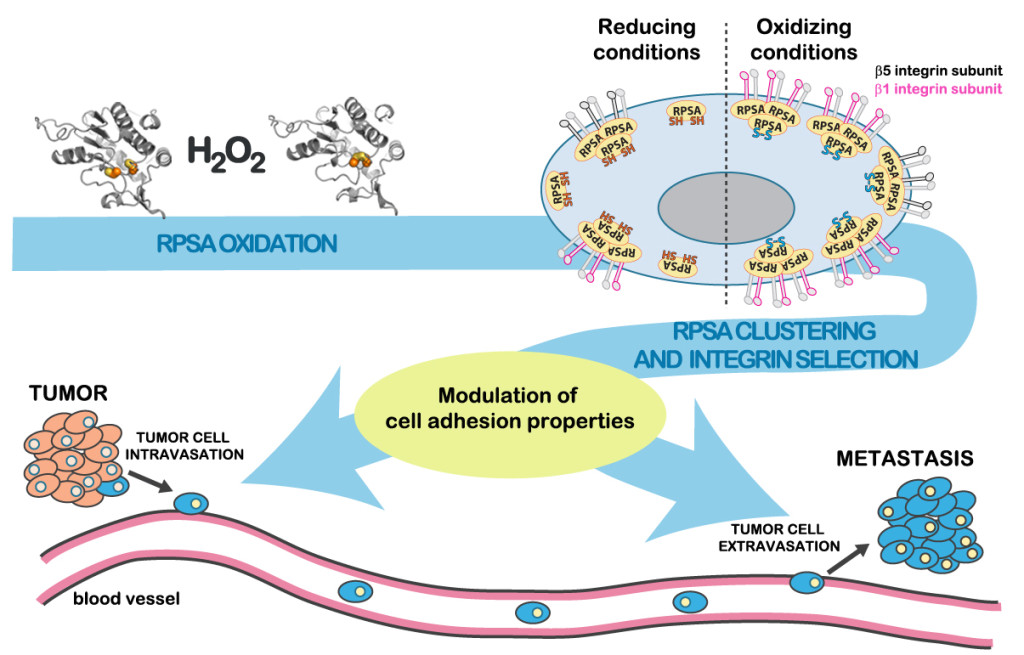How can cancer cells use hydrogen peroxide to strive?
Hydrogen peroxide (H2O2) is a well-known antiseptic used in our homes since the 1920s. But did you know that our cells produce this molecule and that at low concentrations H2O2 instructs our cells to do different things, acting as a signaling molecule? In fact, H2O2 may oxidize several cellular components including proteins, altering their function. Healthy cells use H2O2 to regulate several of their behaviors, including proliferation, migration, or even cell-to-cell communication. It is, therefore, not surprising that cancer cells produce higher amounts of this reactive oxygen species and take advantage of this signaling feature of H2O2 to increase their proliferation and migration,.

Fig. 1. RPSA oxidation by H2O2 results in the formation of an intramolecular disulphide (a chemical bond that occurs between two cysteine residues). This leads to increased clustering at the cell membrane level and recruitment of particular integrins to RPSA clusters (e.g. integrin β1 subunit but not integrin β5 subunit), where they are activated. This recruitment selectivity modulates cell adhesion properties such as alterations in binding specificities to different extracellular matrices. This might be particularly important for different events in tumor progression that depend on cell adhesion processes, such as tumor cell intravasation and extravasation leading to metastasis, conferring a selective advantage to RPSA-overexpressing cells in an oxidative environment.
Although the knowledge around this subject has been increasing in the past few years, it is still largely unknown which molecules are oxidized by H2O2 and how this oxidation affects their function. In our recent work, we have found that a protein called Ribosomal Protein SA (RPSA) is oxidized by H2O2 and that this oxidation enhances cancer properties. In fact, RPSA oxidation improves cell adhesion efficiency to the extracellular matrix and promotes cell extravasation (the passing of cells from the blood stream to surrounding tissues, a critical step in the metastatic process). The effect on cell adhesion is most likely mediated by RPSA clusters that accumulate at the cell membrane level and contain specific adhesion molecules called integrins. Interestingly, it appears that different adhesion molecules are present on those clusters depending on the RPSA redox state, suggesting that RPSA oxidation may influence the type of extracellular matrix to which cells adhere.
Our results unravel a new mechanism by which H2O2 modulates the cell adhesion properties and identify RPSA as the H2O2 sensor in this process. Elevated levels of H2O2 produced both in primary tumors and secondary metastatic sites, together with RPSA up-regulation, might confer a selective advantage to tumor cells in the metastatic process by contributing to alterations in cell adhesion properties such as binding specificity. The identification of redox-regulated proteins, such as RPSA and the determination of their relevance in tumor development will be essential to design more specific and efficient redox-based therapies for cancer.
Filipe Vilas-Boas and Carla Real
Centro de Química e Bioquímica, Faculdade de Ciências, Universidade de Lisboa
Lisboa, Portugal
Publication
Hydrogen peroxide regulates cell adhesion through the redox sensor RPSA.
Vilas-Boas F, Bagulho A, Tenente R, Teixeira VH, Martins G, da Costa G, Jerónimo A, Cordeiro C, Machuqueiro M, Real C.
Free Radical Biology & Medicine. 2015 Nov 18
Related Articles:
 | Short hydrogen bonds in proteins and their quantum… The assembly of linear polypeptide chains into functional three-dimensional protein architectures involves a unique force called hydrogen bonding. A typical hydrogen bond forms when the donor and acceptor groups approach… |
 | Murburn concept explains why oxygen is acutely… Murburn concept (from “mured burning”, signifying a restricted uncontrolled oxidative process) provides a tangible rationale why oxygen is so quintessential for immediate maintenance of life-order. It postulates that oxygen-centered diffusible… |
 | BioID screen for bacterial virulence proteins: new… The discovery of penicillin in the 1920s revolutionized our ability to treat bacterial infection. However despite the introduction of antibiotics, infectious bacterial pathogens remain an immense challenge for the healthcare… |
 | Defects in mismatch repair increase cancer risk and… Microsatellites are formed by 1-6 nucleotide base pairs that are repeated in direct order 5-50 times. Repetitive DNA including microsatellites are mainly present in non-coding DNA regions that occupy more… |
 | The SETOC: Visualizing carcinogenesis through a… The Systemic-Evolutionary Theory of the Origin of Cancer (SETOC) is a recently proposed theory based on two fundamental principles: (i) Margulian evolution as a process of cooperation and endosymbiosis and… |
 | Eavesdropping on cell communications to treat cancer… An estimated 19.3 million new cancer cases and almost 10 million cancer deaths occurred worldwide in 2020. It’s estimated that one in three individuals will be diagnosed with some kind… |







Leave a Reply
You must be logged in to post a comment.